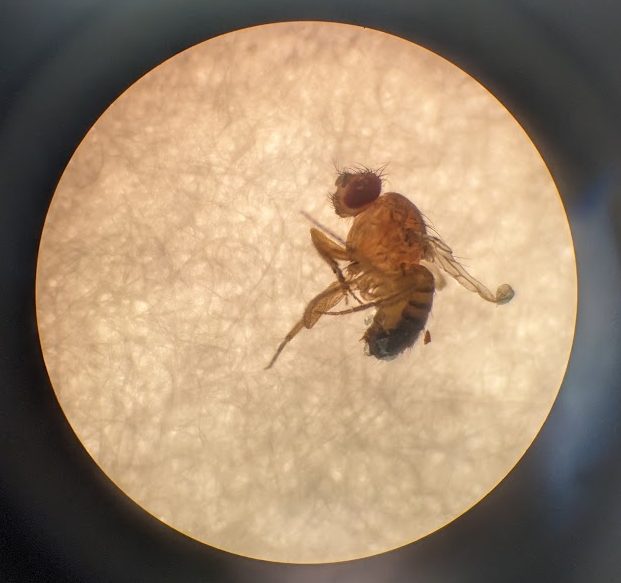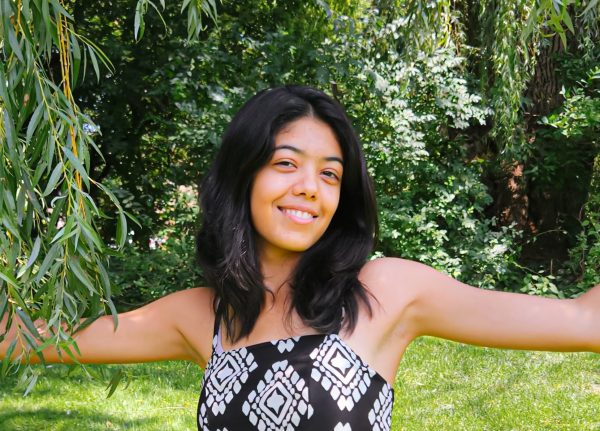Buzzing around the halls of FHC are small mutant fruit flies bred by the AP Biology class.
This is the product of a genetics lab the students are running. They started with purebred flies with various traits and have been growing new populations, transferring the flies from vial to vial. Inevitably, some flies have escaped in the process.
AP Biology student senior Ryan Brom recounts witnessing a few incidents himself.
“It was pretty funny [when AP Biology teacher Patricia] Richardson was setting up the lab and showing us how to nap flies in the other room,” Ryan said. “She knocked it over, and all of the flies escaped. We joke about that pretty often.”
Accidents aside, the lab intends to see how the rules of genetics play out with the sample populations of fruit flies. Given their short lifespans, the flies reproduce within two weeks, allowing the students to track individual traits of eye color and body structure through the generations.
For AP Biology student junior Lia Stevenson, the lab is a great chance for her to observe her flies in hopes of answering some of the questions she’s had about evolutionary biology.
“I would like to know more about the genetic mutation stuff I was able to [work with],” Lia said. “Especially with the vestigial wing flies—they can’t even fly. How are they able to survive and keep growing and reproducing even though they have [this disadvantage]?”
In addition to getting a hands-on experience to learn the concepts they will be tested on, the fruit fly lab offers students insight into how labs with living organisms run.
Not only is this lab time-sensitive but there is also a lot more unpredictability with what the flies do and the traits they possess. This gives the students a chance to experience the challenging surprises that are thrown their way.
“Using these living things, we can’t make them do what we want them to do,” Richardson said. “We’re at the mercy of ‘when do they mate? Do they survive? How many females are there?’ One of the groups yesterday was looking at flies. They had six flies, and they’re like, ‘They’re all male—that can’t happen. It should be three.’ It can happen. Nature doesn’t follow what we say all the time. So, [the lab] is to have that productive struggle through using a living organism and having to really watch what you’re doing and do it for a long period of time.”
This is something that Lia experienced as well with her assigned fruit flies. And, with the difficulty of relying on random chances to get females to use for breeding the next generation, getting lucky is an incredibly joyful moment.
Lia found that this helped her connect with her fruit flies even more.
[My favorite part has been] seeing my girl lay her eggs. She is a queen, [an] iconic star. I love her. Slay.
— Lia Stevenson
“[My favorite part has been] seeing my girl lay her eggs,” Lia said. “She is a queen, [an] iconic star. I love her. Slay. I thought she was dead for a while. She was just laying there, but it turns out, she was just sleepy because the next day, she started flying around, and I was like, ‘Me, too, girl,’ because I’m sleepy, and I can really relate to the female on a different level.”
The perseverance involved in staying focused on the lab despite the spontaneity of the flies is what makes this lab more than just a science experiment.
Richardson loves seeing students progress through this process and, at last, reach the excitement of success, as Lia had.
“Watching [my students] struggle—honestly, it’s my favorite part,” Richardson said. “It’s always exciting to get to the point where people are like, ‘Oh my gosh, it worked, and we’ve got our females!’ [I love] seeing the ups and downs that happen through and then being excited when it does work and when you see what you get.”
This challenge is further amplified by the fact that it is almost entirely in the hands of the students.
The AP Biology students are the ones moving their flies from vial to vial and examining their traits under the microscope, taking notes, and analyzing the genetic makeup of the populations along the way.
Watching you guys struggle—honestly, it’s my favorite part. [I love] seeing the ups and downs that happen through and then being excited when it does work and when you see what you get.
— Patricia Richardson
“I think it’s nice to have a little bit more freedom,” Ryan said. “It’s more of us [doing it] as opposed to a teacher walking us through every step. Obviously, she’s explained things and answered questions we’ve had, but it’s nice to have a little bit more responsibility.”
This responsibility is just one aspect of the fruit fly lab that is done by many high school and college classes. These AP Biology students are learning about genetics through a weeks-long, engaging, hands-on experience as they tackle unexpected challenges of skewed fly gender ratios and, of course, unexpected fly-escaping incidents.
With this, there’s one part of the lab that especially stands out to Richardson—it’s a challenge for everyone.
“One of my favorite things out of the lab itself [is that] it doesn’t matter [what] your academic ability [is],” Richard said. “Students can be really high [achieving] academic students and still fail to get virgin females. So, [the lab] allows an equal playing ground in terms of how successful you are at getting flies. I always love when I have kids that maybe struggle a little more in the class, but they’re super successful at their flies versus students that the class comes easy to, and then, they have a struggle because I think everybody has to see that balance of their struggle in everything.”






















































































